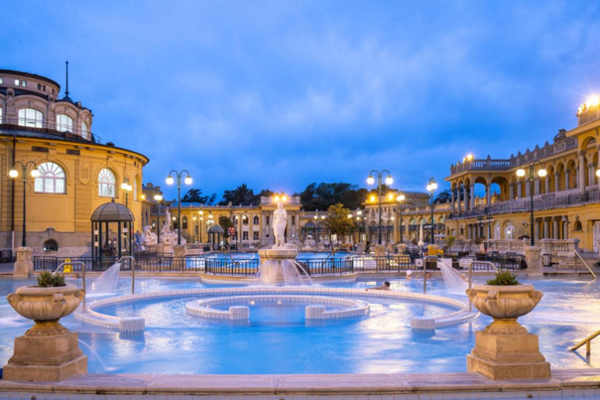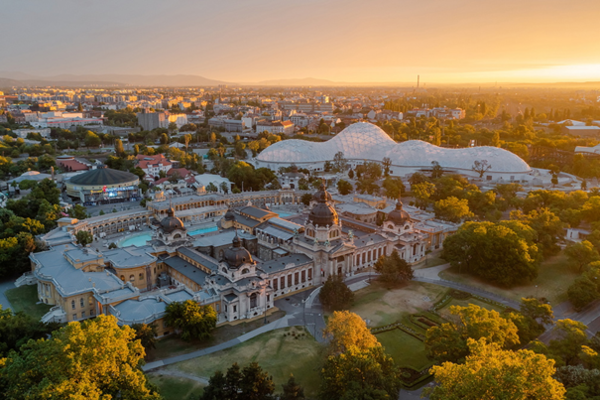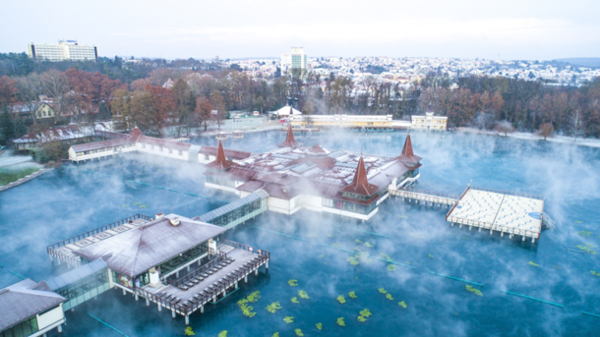Thermal Bath Culture in Hungary

[아츠앤컬쳐] 유럽의 중심부에 위치한 헝가리는 바다나 대양과 맞닿아 있지 않음에도 불구하고 풍부한 수자원을 자랑하는 내륙 국가다. 뛰어난 온천 및 지열 조건 덕분에 헝가리는 일본, 아이슬란드, 이탈리아, 프랑스에 이어 세계에서 다섯 번째로 큰 온천 자원을 보유하고 있다. 헝가리 전역에 1,300개 이상의 온천이 있으며, 부다페스트에만 123개의 온천이 있어 세계 유일의 온천 도시 수도로 일년 내내 스파를 경험할 수 있다.
헝가리의 스파 전통은 로마 시대까지 거슬러 올라가지만, 부다페스트의 상징적인 온천탕 중 일부는 오스만 제국이 통치하던 150년 동안 건설되었다. 이 16세기 터키식 목욕탕은 돔형 천장이 덮인 중앙 팔각형 풀에 빛줄기가 아래 수면을 비추는 특징이 있다. 메인 풀을 둘러싼 소형 풀과 사우나, 스팀룸도 갖추고 있다. 루더시, 키라이, 벨리베이 온천탕은 다뉴브강 부다 지역의 천연 온천 근처에 위치한 대표적인 예다.

터키식 목욕탕 외에도 부다페스트는 다양한 역사적 스파 시설로 ‘스파 도시’라는 명성을 얻었다. 특히 네오바로크 양식의 세체니 온천탕의 김이 나는 야외 풀에 둥둥 떠 있는 판자 위에서 체스를 두는 상징적인 모습은 잊을 수 없는 장면이다. 도시공원 내 성 같은 건물 안에는 열 개가 넘는 풀, 스팀룸, 사우나가 있어 방문객을 사로잡는다. 또 다른 하이라이트는 1918년에 지어진 겔레르트 온천탕으로, 프레스코 천장, 정교하게 조각된 기둥, 타일 모자이크, 조각상 등으로 장식된 아르누보 양식의 걸작이다.

부다페스트 외에도 헝가리에는 주목할 만한 스파 명소가 많이 있다. 발라톤 호수 북서쪽 근처의 헤비츠 호수는 10에이커가 넘는 독특한 천연 온천호다. 연꽃이 떠 있는 따뜻한 물은 겨울에도 매력적이며, 호수 주변에는 호텔과 웰니스 센터가 자리 잡고 있어 미네랄이 풍부한 머드로 다양한 치료법을 제공한다.
또 다른 독특한 장소는 헝가리 북서부 미쉬콜츠 터폴처의 동굴 온천이다. 유럽에서도 유일한 이 온천은 자연 동굴에 흐르는 온천수가 특징으로, 다양한 수온의 다섯 개의 목욕탕이 있어 자연 속에서 특별한 스파 경험을 선사한다.

헝가리의 온천수는 미네랄 함량이 높아 약수로 분류되며, 근골격계, 부인과 및 심혈관 질환 완화에 도움이 될 수 있다. 이처럼 다양한 온천수의 치유 특성은 휴식과 치유를 원하는 방문객을 끌어들인다. 각기 다른 요구에 맞춘 다양한 스파 시설이 있어 누구나 완벽한 스파 경험을 즐길 수 있다.
헝가리의 스파는 특히 겨울철에 인기가 많아, 현지 주민과 해외 관광객 모두에게 활력과 치유의 기회를 제공한다. 추운 계절에 헝가리를 방문한다면 독특한 건축물과 경관을 감상하며 따뜻한 온천수에 몸을 담그는 여유를 놓치지 말기 바란다.
Thermal Bath Culture in Hungary
Situated in the heart of Europe, Hungary is a landlocked country renowned for its rich water resources despite the lack of access to seas or oceans. Thanks to its exceptional balneological and geothermal conditions, Hungary ranks as the world's fifth-largest source of thermal water worldwide, following Japan, Iceland, Italy, and France. With more than 1,300 thermal springs—123 of them in Budapest alone, making it the only capital in the world having thermal baths — the country offers endless opportunities for year-round spa experiences throughout the nation.

Hungary’s spa traditions date back to Roman times, but some of Budapest's iconic bathhouses were built during the 150 years of Ottoman rule. These 16th-century Turkish baths are characterized by central octagonal pools covered by domed ceilings that allow streams of light to illuminate the water below. Smaller pools, as well as saunas and steam rooms, surround the main pool. The Rudas, Király, and Veli Bej Thermal Baths are some of the finest examples, located on the Buda side of the Danube, near natural thermal springs.

In addition to its Turkish baths, Budapest is famed for its wide variety of historic spa facilities, earning it the reputation as “Spa City.” The outdoor pools of the neo-baroque Széchenyi Thermal Bath are truly memorable, especially with the iconic sight of locals playing chess on floating boards in the steamy pool. Inside the castle-like building in City Park, visitors can explore more than ten pools, steam rooms, and saunas. Another highlight is the Gellért Thermal Bath, a secessionist-style masterpiece built in 1918. Known for its frescoed ceilings, intricately carved columns, tile mosaics, and statues, it’s considered one of Budapest’s most visually stunning spas.

Beyond Budapest, Hungary offers numerous remarkable spa destinations. Lake Hévíz, located near Lake Balaton’s northwestern shore, is a unique natural thermal lake spanning over 10 acres. Its warm waters, adorned with lotus flowers, are inviting even during winter, the lake is surrounded by hotels and wellness centers offering treatments, including therapies using its mineral-rich mud.
Another standout is the Cave Bath in Miskolctapolca, in the country’s northwest. This one-of-a-kind European attraction features thermal water flowing through a natural cave system. With five bathing halls offering waters of varying temperatures, it’s a magical spa experience set amidst nature.

Hungary’s thermal waters are often classified as medicinal due to their high mineral content, which can help alleviate musculoskeletal, gynecological, and cardiovascular ailments. The variety and therapeutic properties of these waters attract visitors seeking relaxation and healing. With a wide range of baths catering to different needs, there’s a perfect spa experience for everyone.
Hungarian spas are especially popular during winter, drawing locals and tourists from abroad alike for rejuvenation and healing. If you are visiting Hungary during the colder months, do not miss the chance to unwind in warm thermal waters while taking in the unique architecture and landscapes of these exceptional spas.

글 ㅣ Katalin Ruzsa
주한리스트헝가리문화원 문화사무관
Liszt Institute - Hungarian Cultural Center Seoul


